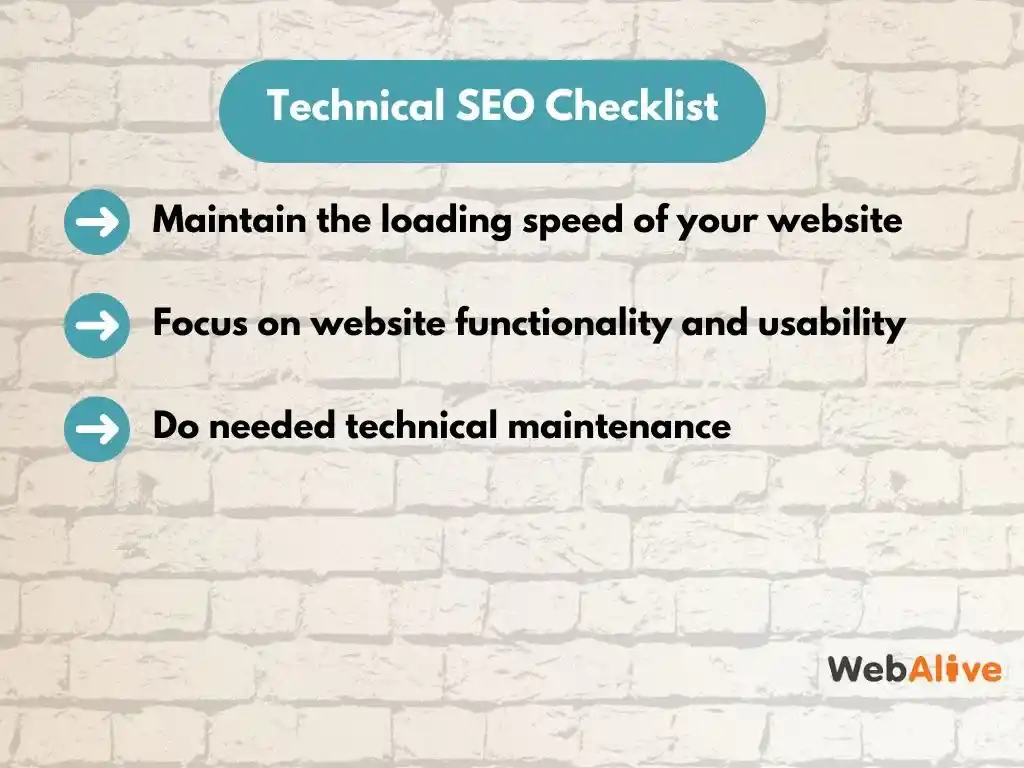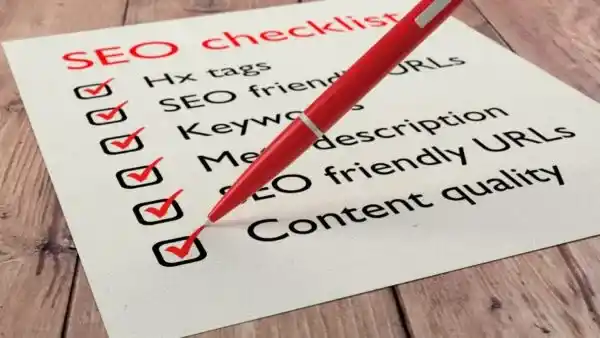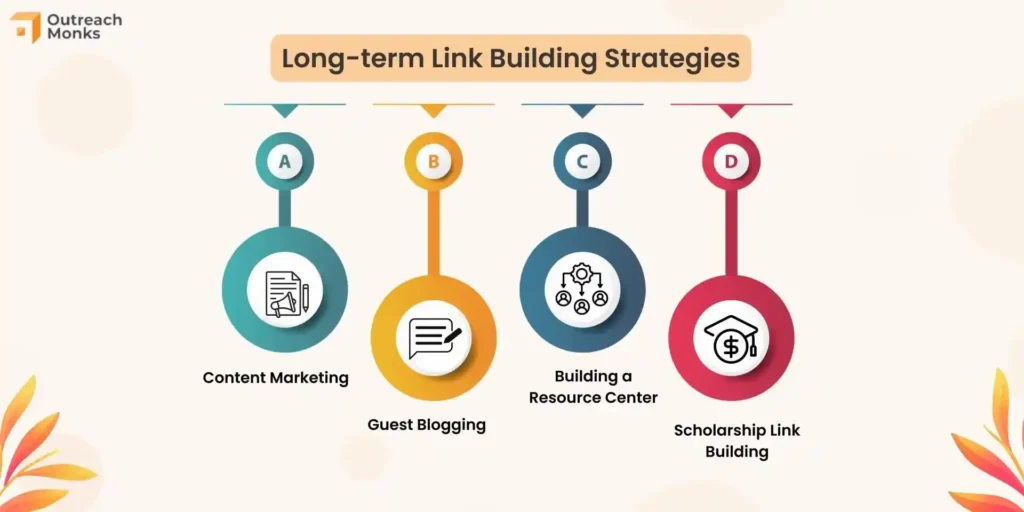Unlock the secrets to Grow your website traffic!
There are the Complete SEO checklist and top tactics, techniques that lead and guide us to growing traffic naturally for multiple brands, having tried them. They are also perfect for Shopify sites, local enterprises, affiliate websites as well as e-commerce stores among others.
This complete list on How to do SEO includes Technical SEO, On-Page SEO and Keyword Research which make it useful regardless of whether you know nothing about the subject or have some experience in it. Find out how to use the best meta tags & create website structure that can facilitate optimization. Here’s a complete SEO checklist with 38 helpful suggestions to increase your website’s performance. Download the PDF version at the end of the post for practical reference.
In this post I give 38 tips of Complete SEO Checklist for Downloding
Table Of Content
- SEO Basics Checklist
- Keyword Research Checklist
- On-Page SEO Checklist
- Technical SEO Checklist
- Content Checklist
- Link Building Checklist
- Bonus #1: Advanced SEO Tips and Tactics
- Bonus #2: Case Studies and Examples
- Conclusion
SEO Basic Checklist
You can’t expect the website to be SEO-ready just by purchasing a domain name and creating its own If it was such an easy process as this straightforward one makes it seem, why do we even need SEO basics checklist in the first place?

1. Setting up the Google Search Console
In order to monitor your site’s search engine traffic, track search performance, and identify anything that might cause a site not to be ranked, you need to create your Google search console account while accessing the sign-up page as a website owner.
Do not forget to verify your domain by Google before it offers any services on the website so that it can be yours. Teach yourself how to verify domains in order to utiliz it.
Google Search Console is built to keep you informed about how well your website is doing on Google.
That’s the reason why it contains useful features like the following:
- Check which keywords
- Generate the most traffic for you.
- Send in your sitemap.
- Correct website issues
- View experience scores for your page.
- Many more
In brief: If your intention is to take SEO seriously, having a Google Search Console is an important initial process.
2. Subscribe Bing Webmaster Tools
The United States has been the largest search engine after Google, Complete SEO checklist with 15% of all searches. Bing Webmaster Tools is a service from Microsoft which allows you to add your shop or store to the Bing crawler.
Go to the sign-up page and create a free Bing Webmaster account, after which you should then add and verify your website in Bing search results.
Is Google not popular like Bing? No. Roughly 1 billion users per month make use of Bing; therefore it is advisable to optimize for it.
Furthermore Bing Webmaster Tools has some great features that include an in built keyword research tool.
3. Set up Google Analytics
A sitemap provides Google and other search engines information about your site’s structure. If you want to know where people find (and how they use) your site. Therefore, Google Analytics is the ideal tool.
Its many useful features consist of:
- Show how much traffic you are receiving from Google
- Look for the website pages that bring the highest volume of visits
- Observe if the flow of visitors to your site is increasing (and by what measures)
- Establish other websites and search engines that send visitors to your site.
- Also, get the average performance time – pageviews plus average time spent on site per user.
Pro tip: Link your Google search console with Google analytics account so that you can see essential search engine optimization data from within your Google analytics account.
4. Set up Yoast SEO (Only for WordPress Users).
It can be difficult to keep up with algorithm changes in search engine rankings as well as competitor keywords. However, these days there are plenty tools for both free and paid users who want to optimize their website’s visibility through search engines (e.g., moz.com) Complete SEO checklist. Moreover you have already taken the lead when you installed Google Analytics and Console!
Yoast is the most Widely used SEO plugin in the world.
And with a good cause. Yoast makes WordPress website search engine optimization really simple.
5. Create a Free Semrush Account.
Semrush is one of the first tools you should have in your SEO toolbox. There are lots of benefits even in the free version.
This is the reason.
Monitor Your Competitors
Firstly, you can see into the SEO tactics of your rivals using a free Semrush account.
Examine their backlink profile, organic performance, and popular keywords. Learn what makes them successful, then utilize that knowledge to strengthen your own plan
Checklist for Keyword Research
Keyword research is the foundation of SEO. Additionally, I’ll teach you how to quickly identify relevant terms that prospective buyers are searching for in this checklist.

1. Find Long Tail Keywords Using "Google Suggest"
This is one of the most effective methods for finding long tail keywords.
That’s how it operates:
Start by entering a term into Google.
But avoid clicking Enter. Click the button marked “Google Search Complete SEO checklist.” Alternatively, look at the keywords that Google displays for you:
(These are the keywords for “Google Suggest”).
These keywords are directly from Google, so you KNOW that people are searching for them—some of whom may even be members of your target market.
This indicates that you should improve your website using them as valuable keywords.
Technical Advice: Look at Keywordtool.io. The procedure can be scaled considerably more easily because this tool scrapes Google Suggest terms.
2. Use Google Keyword Planner to Locate Strong Keywords
The official tool for researching keywords offered by Google is the Keyword Planner.
In theory, it is made for Google Ads. But it’s still really helpful for keyword research and idea generation.
After all, Google provides the data directly. You have learned of its extreme accuracy.
A tutorial on utilizing Google Keyword Planner for SEO may be found here.
3. Join Online Communities.
Forums, Reddit, Quora, and other online communities are great resources for keyword research.
Additionally, I made a step-by-step video that explains how to locate untapped keywords in these groups.
Here it is:
4. Use Semrush to Find Low Competition Keywords
A commercial tool for researching keywords is Semrush.
Semrush stands out since it provides a lot of information on every keyword.
As you can see, Semrush provides the following data when you enter a keyword:
1. Search volume
2. The difficulty of the keyword
3. CPC
4. Trends
5. The SERP features
In this manner, you can select easy-to-rank keywords with less competition.
5. Find Out "Question Keywords" Using Public Answers
Question keywords work wonders for articles and blog posts.
(One example would be, “How do you make coffee with cold brew?”)
Answer The Public makes it simple to locate them as well.
You may see questions that people search for online with for free application.
Checklist For On-Page SEO
It is time-consuming and requires effort to prepare your individual pages so they can be ranked. In any case, you will be facing off against some famous brands. With regard to this, make sure that you make use of our On-Page SEO Checklist in order for your web page is as optimized as possible.

1. Use your keyword in your URL.
Google is able to understand the purpose of your page thanks to your URL. Also, a URL packed in keywords might raise your organic CTR.
For this reason, you need to include your keyword within your URL.
For instance, “SEO checklist” is my goal keyword for this website.
2. Use shorter URLs.
Try to make your URLs short as you can.
Why?
According to an examination of 11.8 million Google search results, short URLs had the highest Google ranking.
3. Include your keyword in your title tag.
It’s not secret that you should include your keyword in the title tag.
However, few people are aware that it matters where you place your keyword.
More specifically, if feasible, you should position your keyword in front of your title tag.
4. Use Title Tag Modifiers.
Words and phrases that you can add to your title tag are called modifiers.
When you do, a wide variety of long-tail keywords may rank for your page. Complete SEO checklist!
5. Within the first 150 words, use your keyword once.
Google gives your page’s initial 100–150 words more weight.
Thus, be sure to use your keyword here at least once.
6. In H1, H2, or H3 Tags, use your keyword
Heading (H1) tags serve as a page’s primary headline and typically include the primary keywords for the content of the page. These details support search engines to understand a page’s context.
Make sure the H1, H2, or H3 tags contain your keyword.
7. Image Optimization
Your content can be inferred a lot from the photos you employ.
Sadly, Google is still unable to “see” photographs in the same way that humans do.
Therefore, you want to optimize your filenames and image alt tags to make your photographs easier for people to interpret.
(Advantageously, optimized photos improve your ranking in picture searches.)
Here’s how to do it:
First, give the image a filename that succinctly defines what it is when you save it.
Make sure your images appear in search results by giving each picture a meaningful name (don’t name an image “83798.jpg,” for example).
8. LSI keywords and synonyms
It made sense to “keyword stuff” your page in the past.
Not any longer.
Google is smart in these days.
Therefore, use LSI keywords and synonyms rather than repeating the same keyword a thousand times.
Let’s take an example where you wish to rank for the term “how to start a blog.”
You should use that precise keyword on your page a few times, then. and equivalent terms such as:
How to start a blog
launching a blog
How to launch a blog
How to set up a WordPress blog
You understand 🙂
Add a few LSI keywords after that.
Terms that complement your primary keyword are known as LSI keywords.
9. Use of External Links
Make sure your content has links to at least 5–8 reputable websites.
Additionally, those links demonstrate to Google that my writing is trustworthy and well-referenced.
10. Make Use of Internal Links
This is very simple to do:
Link to two to five other pages on your website with each new post you submit.
Pro Tip: Make your internal links’ anchor message full of keywords.
This informs search engines about the topic of the page I’m linking to, which is “on-page SEO.”
Checklist For Technical SEO
One of the trickier parts of ranking your website is technical SEO, but it’s just as essential. To make sure search engine crawlers can reach your website and users have a positive experience, make sure you follow this technical SEO checklist.

1. Identify Crawl Errors
A “Crawl Error” shows that a page on your website is not being viewed by Google or its search engine bots.
Also, your page will not rank for anything if users are unable to read it in the strategy of Complete SEO checklist
The “Coverage” report in the Google Search Console makes it simple to locate crawl errors:
2. Learn How Google Views Your Page.
On occasion, visitors may view every element on your page.
However, Google is unable to.
Once more:
Your page won’t rank if Google can’t access it completely.
For this reason, I advise making use of the “Inspect URL” function in Google Search Console.
Simply input a page from your website into the GSC’s top field.
3. Make Your Site Mobile-Friendly.
Officially, Google is using a “Mobile-First Index.”
This implies:
It will not rank well if your website is not optimized for mobile devices.
Thankfully, it’s simple to determine whether Google views your website as “mobile friendly.”
You can find out if your website is appropriately optimized for mobile devices by using WebPageTest.
4. Repair Broken Links
Your SEO may actually suffer from broken links.
Thus, it is essential that you look for broken links. and make them right.
The simplest approach to accomplish that? DrLinkCheck.com.
This program, which is free, checks your website for broken links:
5. Use HTTPS to Secure Your Website
A verified Google ranking indication is HTTPS.
It’s therefore time to switch your website to HTTPS if you haven’t previously.
(Or, if you recently built a new website, configure it using HTTPS right away.)
Here’s a how-to for switching your website to HTTPS that won’t harm your SEO.
6. Check Your Website's Loading Speed
Does your website load really quickly?
Your site won’t rank as highly if it doesn’t.
For this reason, Complete SEO checklist you need to visit Google Page Speed Insights.
With the help of this free tool, you can check how quickly mobile and desktop visitors load your website:
It even informs you about how to expedite the process.
Content Checklist
Relevant, interesting, useful, or even fun content on your site actively encourages visitors to hang around longer, ultimately helping to improve search engine rankings, explains Custom Neon co-founder Jake Munday.

1. Use "Skyscraper Technique" to Create Amazing Content.
The Skyscraper Method is an effective strategy for producing outstanding content.
To be exact, I doubled my search engine traffic using this method:
The three steps are as follows:
1. Start by locating a well-liked piece of content within your sector.
2. Then, make something even more superior.
3. Lastly, advertise that material.
Naturally, there isn’t enough space for me to go into further depth about these stages here.
Here are two useful resources to help you learn more about The Skyscraper Technique:
My #1 White Hat SEO Strategy of All Time (59% Increased Organic Traffic)
How I Raised My Search Traffic in Just 14 Days by 110%
2. Divide Your Writing to Make It Easier to Read
Nobody likes to read massive text walls:
For this reason, I ALWAYS divide my writing into digestible sections, such as this:
My bounce rate is kept low by these chunks, which is important for Google ranking.
(I’ll talk more about that later with Complete SEO checklist.)
3. Clearly Discuss the Subject on Your Page
One item jumped out when we examined more than 11 million Google search results:
Google’s top-ranking content typically goes into great detail about a single subject.
For instance, I posted this tutorial on my website quite some time ago.
Use the content formatting advice below to make your material easily readable so that visitors to your website won’t be put off by long, dense text sections:
1. Include a table of contents with jump links; this is a strategy that can help you keep the featured snippet.
2. Make use of multimedia, including charts, movies, and infographics
3. Use bullet points to divide up sections.
4. To add variety to your brief phrases and paragraphs, use Hemingway.
5. Use subheadings to facilitate readers’ skimming
6. Include a FAQ
4. Utilize diagram markup.
Schema markup improves the way search engines understand the material you write.
However, using Schema can be challenging.
I suggest using Google’s Structured Data Testing tool because of this.
Comparing Schema to doing it manually is MUCH harder.
5. Prioritize content formats who are currently effective.
Recently, the Buzz Sumo team examined 100 million articles.
What then did they discover?
First, the negative information:
“Most content receives zero backlinks.”
Hurt.
Here’s some positive news:
They found that some material formats are more effective than others.
More specifically, “websites that have established a solid reputation for unique, authoritative content are the big winners.”
By “original, authoritative” content, what do they mean?
Expert-written content
First-hand investigation (such as surveys and industrial studies)
Content that goes beyond simple recitation of facts Case studies and actual incidents
Content that is timeless and valuable for years
6. Use multi-media
As you may have noticed, there are a TON of pictures in this post.
I do this mostly for two reasons:
It simply produces better content, to start.
Second, multimedia content—images and other—helps content rank higher.
Therefore, I advise incorporating the following multimedia into your content with Complete SEO checklist:
Pictures Infographics Charts
Videos with Visual Content
Interactive surveys and tests
It’s now time to discuss link building, which is a HUGELY crucial aspect of SEO.
Link-Building Checklist
links Building is essential for SEO. In reality, Google has stated that backlinks are among their “top three” ranking criteria. Sadly, developing links is difficult, which is why most other SEO checklists ignore this step. But links are essential if you want to rank in Google. And I’ll talk you through the process in this section.

1. Create Effective Backlinks Through Guest Posting
A very powerful link-building tactic is guest posting.
Having stated that,
It is not always correct to guest post.
Correct method: Post your guest post on reputable websites related to your field.
The incorrect approach is to post guest articles on any website with a “write for us” section.
To be honest, I exclusively guest post on websites that would drive relevant traffic to me.
2. Flip Your Competitor’s Backlinks
When you can duplicate the link sources of other companies, why create another source of links?
You’ll need a link analysis tool to accomplish this.
For myself, I utilize Semrush.
However, you can use a premium tool like Link Explorer (from Moz) if you’re on a tight budget.
Whatever tool you select, the procedure is always the same:
Take note of your rival’s URL.
Place it inside the instrument.
Get as many of their links as you can, to sum up. Its the Complete SEO checklist.
It will be almost impossible to duplicate some of these links.
(For instance, connections from websites with which I am affiliated.)
3. Create Contextual Backlinks Using Link Roundups
Knowing the background is particularly helpful: What made these websites choose to link to your rivals? What aspects of the page warranted a link?
Identifying these patterns—for example, if rival blogs receive a lot of mentions from journalistic content—can assist you in choosing collaborators. Additionally, you may figure out what other website owners in your industry need, so you can provide them enough of a benefit in exchange for a high-quality connection.
4. Invite Someone to a Podcast
It’s similar to guest posting.
But you look as a guest on a podcast rather than writing an article.
I received a nice backlink as well as a few targeted traffic, as you can see.
5. Relate Influencers To Your Blog Posts
It’s really easy to follow this process:
Start by mentioning well-known bloggers in your writing.
Tell them you mentioned them after that.
(Really, that is all.)
They also gladly shared my stuff on social media, as you can see.
Bonus #1: Advanced SEO Strategies and Advice
Do you want to boost the rating of your website? It’s time to improve your SEO skills! Concentrate on obtaining recommendations from online buddies in order to create amazing backlinks to your website. To attract the right folks, try utilizing longer, more targeted phrases rather than just incredibly popular ones.
Make incredibly informative, readable material that others will want to share. Employ analytical techniques to learn about users’ preferences and website usage patterns, and then provide the necessary support. Keep in mind that SEO is constantly evolving, so never stop learning and experimenting!

1. Optimise Your Website for Click-Through Rate
Consider the webpage as an online shop. It is your intention for others to see it and desire to enter. This is the purpose of click-through rate, or CTR. It refers to how frequently users find your website through search results and click to visit it.
Make sure the name and description of your website are really clear and captivating in order to increase your keyword ranking. Use language that attracts people’s interest and draws them in. Keep in mind that no one like waiting around, so make sure your website loads quickly!
Choosing images that complement your website’s theme and look excellent is another piece of advice. It’s also important to remember and make it simple to type in the address of your website. These measures will help you improve the invitingness and conversion rate of your website.
2. Reduce website downtime
Users become irritated when your website is down.
It turns out that Google too gets upset.
Unplanned site outages, in fact, “can negatively affect a site’s reputation,” according to their statement.
Fortunately, a tool like Pingdom makes it simple to monitor site downtime.
Your website is pingged hundreds of times a day by Pingdom.
You’ll be notified if it goes down so you can address the issue right away.
you’ll want to note down this points with Complete SEO checklist
3. Remove "Dead Weight" pages.
Google recently stated that a large site with many pages can be detrimental to SEO.
I make sure that every page on my website is AMAZING because of this.
To put it another way, I prioritize 100% quality.
This quality over quantity strategy obviously works, however I see a lot of sites having trouble with “Dead Weight” pages.
Dead Weight pages such as
1. Pages for categories and tags in WordPress
2. Out-of-date blog entries
3. Identical content 4. Blog entries of poor quality
5. Product pages on e-commerce sites with no sales
6. Pages from archives
7. Boilerplate or thin content
8. Pages for previous services
Furthermore, Complete SEO checklist with Google has said that these Dead Weight pages may harm your SEO efforts, as you have just seen. Thus, I advise getting rid of them.
4. Boost Your Site's Dwell Time
Dwell Time is another important Google ranking metric.
Google wants users to remain on your website.
Google gets notified if users leave your page quickly and go to another search result.
5. Modify and relaunch old material.
Keep your old items from collecting dust! Give it a fresh start! Look for those once-popular older blog entries or pages. Apply a new coat of paint on them to bring them back into the spotlight. Revise outdated material, create new sections, or enhance pictures and videos. By doing this, you offer search engines an incentive to revisit your material in addition to providing your readers with something fresh to appreciate. Think of it as recycling for your website!
Bonus #2: Examples and Case Studies
Would you like to witness SEO in action? Let’s examine a few actual instances! Find out how companies similar to yours increased their website ranks by implementing these SEO tactics. From small businesses to large corporations, we will demonstrate their methods and share insights with you. Prepare to be motivated as you discover the ideal SEO tactics for your own achievements!

1.How can Improve On-Page SEO Optimization
Improving your website’s appearance for search engines is similar to on-page SEO. It all comes down to making your pages visitor-friendly and simple to navigate. This is how you can make it better:
- Create amazing content: Write informative and engaging articles that readers will enjoy. Answer people’s queries and speak in plain English.
- Employ the appropriate keywords: Look for terms that people use to find your content. Don’t overdo it when using them in your page headers, headings, and text!
- Make interesting page titles and descriptions. Your descriptions and titles need to encourage readers to click on them.
- Make use of subheadings and headers: To make your information easier to read and comprehend, divide it up using headings and subheadings.
- Make your photos more optimized: To help search engines understand the purpose of your photographs, give them meaningful titles and include alt text.
- Establish reliable internal connections: Provide links between the many pages on your website so that search engines can better grasp your site’s.
Just keep in mind that when it comes to on-page SEO, it is only but one piece of the puzzle. You should bring it together with other SEO strategies if you want to see great performance!
2. How (Quickly) Improved His CTR by 64.1%
Assume increasing website click-through rates by an astounding 64.1%! Sounds incredible, doesn’t it? Yes, it did indeed occur. Somebody came up with a really clever method to accomplish that. Watch what they accomplished.
They looked closely at their website first. They observed how users were arriving at their website and their actions once they were there. This made it easier for them to determine what was and wasn’t functioning.
They then employed inventive headlines. They promised amazing things and made them incredibly intriguing and catchy. People were unable to stop clicking!
They also created their website quite quickly. They made sure their pages loaded quickly because nobody wants to wait around.
And what do you know? Their efforts paid off! Their incredible 64.1% increase in click-through rate (CTR) was achieved! That’s a significant victory!
3. How to Inspire Users to Spend More Time on His Site
Do you want visitors to spend more time on your website? It’s similar to inviting a friend around; you want them to be at ease and enjoy themselves! This is how you do it:
Make sure your website is incredibly user-friendly first. Nobody enjoys being confused or angry. People will be satisfied with basic designs, easily accessible items, and clear options.
Next, send them fantastic material! Tell tales, offer advice, or discuss topics that are important to people. People will remain longer if your content is more informative and engaging.
Remember to include images and videos! They add humor and clarity to the situation. They can also enhance the appearance of your website!
Conclusion
So, that’s it! We’ve covered a lot of an area in SEO, from the fundamentals to more advanced methods. Keep in mind that SEO is all about making your website more visible to search engines, so make sure your material is entertaining, helpful, and easy to locate. Don’t be worried to try new things and pick up new skills along the way—use the checklist as a guide. You can reach more people and raise your website’s rating with a little work. Wishing you luck!
Download the Complete SEO Checklist PDF
Remember, SEO is an ongoing process, and consistency is key. Keep learning, stay updated, and watch your website climb the search engine rankings!

[…] picture yourself talking to a friend and that is how you should phrase it on your website during a voice search session. In place of using rigid sentences stuffed with keywords you can apply natural language and […]
[…] Engagement: Before the client even asks for help, predict their needs and give suggestions or […]
cost of aripiprazole
how long does aspirin take to work
Hi there to all, because I am genuinely keen on reading this website’s posts to be updated on a regular basis. It carries pleasant stuff.
I am constantly browsing online for articles that can help me. Thx!
Undeniably believe that which you said. Your favorite reason seemed to be on the web the easiest thing to be aware of. I say to you, I certainly get irked while people consider worries that they plainly do not know about. You managed to hit the nail upon the top and defined out the whole thing without having side-effects , people could take a signal. Will likely be back to get more. Thanks
With the whole thing that appears to be building throughout this particular subject material, your points of view happen to be quite radical. On the other hand, I am sorry, but I do not subscribe to your entire plan, all be it radical none the less. It seems to me that your remarks are not entirely rationalized and in fact you are your self not even entirely confident of the assertion. In any event I did take pleasure in reading through it.
Thank you for reading and sharing your thoughts! I appreciate you acknowledging the radical nature of my ideas. I understand that not everyone will agree, and I’m always open to constructive criticism. I’m still developing these ideas myself, and your feedback is valuable in helping me refine them.
Hello there! This is my first visit to your blog! We are a team of volunteers and starting a new project in a community in the same niche. Your blog provided us useful information to work on. You have done a marvellous job!
Thanks! and If you need any help with me let me know I’ll be happy to help
Great ?V I should certainly pronounce, impressed with your website. I had no trouble navigating through all tabs as well as related information ended up being truly simple to do to access. I recently found what I hoped for before you know it in the least. Reasonably unusual. Is likely to appreciate it for those who add forums or something, web site theme . a tones way for your client to communicate. Excellent task..
I’ve been browsing on-line more than 3 hours as of late, yet I by no means discovered any interesting article like yours. It?¦s lovely value sufficient for me. In my view, if all webmasters and bloggers made good content as you did, the internet can be much more useful than ever before.
Thank for such good words
I just could not depart your site before suggesting that I actually enjoyed the standard information a person provide for your visitors? Is going to be back often in order to check up on new posts
Thanks We’re Happy you like it. If you have any question let us know